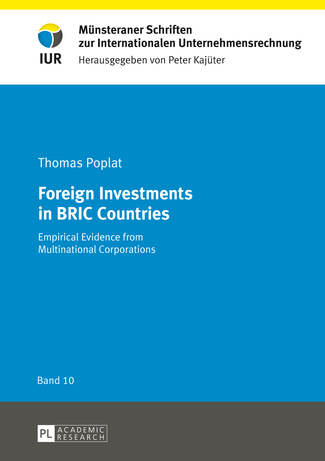Band 10
Thomas Poplat – Foreign Investments in BRIC Countries
Empirical Evidence from Multinational Corporations, Frankfurt a.M. et al. 2013.
 Multinational corporations undertake significant investments to establish subsidiaries and production sites in foreign countries. In recent years, investments in BRIC countries were a main driver of the substantial growth of worldwide investment flows. Particularly in times of stagnating growth in North America and Europe, BRIC countries provide business opportunities and growth potentials, but they also entail significant risks as institutional voids, host governments and national champions determine the local business conditions. Thus, a systematic decision process is necessary to anticipate upcoming investment opportunities and risks.
Multinational corporations undertake significant investments to establish subsidiaries and production sites in foreign countries. In recent years, investments in BRIC countries were a main driver of the substantial growth of worldwide investment flows. Particularly in times of stagnating growth in North America and Europe, BRIC countries provide business opportunities and growth potentials, but they also entail significant risks as institutional voids, host governments and national champions determine the local business conditions. Thus, a systematic decision process is necessary to anticipate upcoming investment opportunities and risks.
Despite the high failure rate of investments targeting BRIC countries the design of the underlying decision processes in multinational corporations is largely unexplored. This work reduces this research gap by investigating corporate decision-making processes of BRIC country investments. A multiple case study design involving two multinational corporations and more than 50 interviews with managers, business developers and management accountants serves to analyze BRIC investment decision processes in their real-life context. Thereby, the empirical data derived from twelve Greenfield investment projects are analyzed on the firm- as well as on the country-level. Finally, the firm-and country-level findings are consolidated in a cross-level synthesis.
On the firm-level a pre-developed foreign investment decision process model serves to analyze the two firm-specific decision processes from different perspectives. A cross-company comparison based on a conceptual framework provides explanations for firm-specific differences. Furthermore, the work illustrates how the two drivers of investment decision process efficiency – decision process speed and decision process comprehensiveness – are influenced by industry specifics and organizational characteristics. In addition, a role constellation of power, process and technology promotors is recommended which balances the conflicting forces for decision process speed and comprehensiveness to attain decision process efficiency. The application of the promoter model delivers managerial implications for the design of foreign investment decision processes.
The country-level analysis focuses on identifying political-economic and socio-cultural challenges which foreign investors face in the BRIC countries. Significant regional differences between urban and rural areas with respect to infrastructure, education and the availability of qualified employees as well as socio-cultural diversity are the main challenges foreign investors have to overcome in each of the four countries. The country-level analysis provides interesting results for internationally less experienced companies which consider investing in the BRIC countries. Finally, the cross-level analysis serves to connect the firm-and country-level results. The specific challenges in Russia demand for higher decision process comprehensiveness along the entire process. The three other countries require higher decision process comprehensiveness in the early stages of the investment process, so that the following operational phases can be focused on decision process speed.


